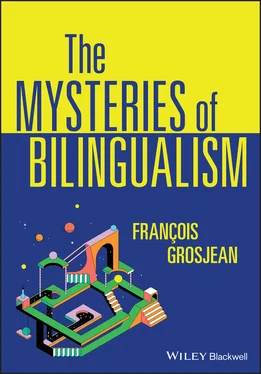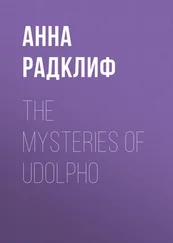For the last 40 years or so, I have defined bilinguals as those who use two or more languages (or dialects) in their everyday lives . Putting the emphasis on language use does not do away with language proficiency though, since you cannot use a language if you do not know it to some extent. But the range of who can be considered bilingual increases considerably with this definition. As I wrote in Bilingual: Life and Reality (Grosjean 2010), at one end of the range we find the migrant worker who may speak with some difficulty the host country’s language and who does not read and write it. At the other end, we have the professional interpreter who is fully fluent in two languages. In between, we find the scientist who reads and writes articles in a second language but who rarely speaks it, the foreign-born spouse who interacts with friends in his first language, the member of a linguistic minority who uses the minority language only at home and the majority language in all other domains of life, the Deaf person who uses sign language with her friends but a spoken language (often in its written form) with a hearing person, and so on. Despite the great diversity among these people, they all share a common feature: They lead their lives with two or more languages.
I insist on two or more languages in my definition as some people use more than two languages regularly. If one wants to be specific regarding a particular person, one can specify exactly how many languages they use on a regular basis by using words like “trilingual,” “quadrilingual,” “quintilingual,” etc. As for the word, “multilingual,” many prefer to use “bilingual,” as “multilingual” is mainly used to characterize societies or countries (e.g., Switzerland is a multilingual country). In addition, at least in Western societies, the majority of bilinguals only use two languages regularly, reinforcing the bi- in bilingual even though they may know several others. For example, I know some Italian, Spanish, American Sign Language, and even Latin, but I only use English and French on a regular basis. Thus, in terms of language use, I am only bilingual. Finally, dialects is in the definition I propose, and it is starting to appear in others too, as in some parts of the world (e.g., Italy, Switzerland, Arabic-speaking countries, etc.), dialects are a linguistic reality and people can be bilingual in a majority language and a dialect. They can also be trilingual in a national language, and in two dialects, for example. A final point should be made regarding emphasizing language use in definitions. I have found that it allows many people who live with two or more languages to accept their bilingualism and be proud of who they are. This they could not do when fluency – often equal fluency – in two or more languages was the main criterion for identifying oneself as bilingual.
Definitions have never replaced a good description of a phenomenon, and this also true for what it means to be bilingual. In what follows, I will present some important characteristics of bilingual people, first at a particular point in time in their lives, and then over the years, as is revealed in their language history.
At a Particular Point in Time
Language proficiency and language use are probably the two foremost factors (variables) when describing bilinguals at a particular point in time. A third one, when they actually started to become bilingual, will be dealt with in their language history below. A grid approach proposed by Grosjean (2010) can help us visualize proficiency and use together (see Figure 1.1).

Figure 1.1 A visual representation of a bilingual’s language proficiency and language use.
Language use is presented along the vertical axis (from Never used at the bottom all the way to Daily use at the top) and language proficiency is on the horizontal axis (from Low proficiency on the left to High proficiency on the right). These labels can be replaced with numerical values if necessary. An example allows us to see the three languages of Lucia, a bilingual, and where they stand in relation to one another. Her most used and most proficient language is La (French). Her other language, Lb (English), is used slightly less frequently and she is slightly less proficient in it, although the level is still very high. This explains why its position is just below and to the left of La in the figure. She also knows a third language, Lc (German), but not very well, and she uses it rarely. Hence its position in the lower left of the grid. Lucia is clearly bilingual in English and French, on both factors, and like many others, she also has some knowledge of another language but rarely uses it. Note that in this type of presentation, the position of each language can be based either on self‐assessment ratings, as in this case, or on the results of more objective tests.
Separate grids can be used for each of the bilingual’s four language skills (speaking, listening, writing, and reading) since it is often the case that amount of use and degree of proficiency can be quite different in these skills in the different languages. Thus, some bilinguals may have very good oral comprehension of a language but may not speak it very well; others may know how to read and write one of their languages but not the other(s), and so on. A few years after the grid approach was proposed, two other researchers, Luk and Bialystok (2013), provided statistical evidence that bilingual experience does indeed involve at least two dimensions, language use (they call it bilingual usage) and language proficiency, and that these dimensions are not mutually exclusive. These variables are the first building blocks of the description of the bilingual to which others need to be added, as we will now see.
If one is interested in a bilingual’s language use, one will invariably be confronted with the functions of the person’s languages, that is which language is used, when, for what and with whom. More than half a century ago, Weinreich (1953) had already stated that many bilinguals are accustomed to discuss some topics in only one of their languages. Several years later, Mackey (1962) divided language functions into external functions (language use in various situations and domains) and internal functions (the non‐communicative uses of language such as counting, praying, dreaming, etc.). Clearly not all facets of life in bilinguals require the same language, nor do they demand both languages. Based on this, Grosjean (1997, 2016 ) proposed the Complementarity Principle, which he defined as follows:
Bilinguals usually acquire and use their languages for different purposes, in different domains of life, with different people. Different aspects of life require different languages.
The principle is discussed and illustrated in Chapter 8, so it suffices to say here that it has an impact on a number of variables, notably language proficiency. If a language is spoken in a reduced number of domains and with a limited number of people, then it will not be developed as much as a language used in more domains and with more people. In the latter case, there will be an increase in specific vocabularies, stylistic varieties, discursive and pragmatic rules, etc. It is precisely because the need and use of the languages are usually quite different that bilinguals do not develop equal and total proficiency in all their languages. This is also true for the different language skills, such as reading and writing.
Language proficiency, language use, and functions of languages influence two other variables that are proposed when describing bilinguals. The first is language mode (Grosjean 2001), and the second is language dominance. Concerning language mode, which will be treated in more depth in Chapter 7, bilinguals have to ask themselves two questions when communicating with others: “Which language should be used?” and “Should the other language be brought in?” The answer to the first question leads to language choice, that is, choosing a base language for the exchange. As concerns the second question, bringing in or not the other language, if the answer is “no,” then the bilingual is in a monolingual mode. This is the mode when speaking to monolinguals, reading in a particular language, listening to just one language, etc. If, on the other hand, the answer is “yes,” as when the bilingual is speaking to another bilingual who shares his/her languages and who accepts to change base language from time to time and intermingle them (e.g., code-switch and borrow), then the bilingual is in a bilingual mode. Here, both languages are activated but the base language more so than the other language. Other examples of when the bilingual mode is required are listening to two bilinguals who are mixing languages, interpreting from one language to another, doing a study that requires the two languages, either overtly or covertly, and so on. In between these two endpoints of the continuum, bilinguals can find themselves in various intermediary modes, depending on the situation, the topic, the interlocutors, etc.
Читать дальше













